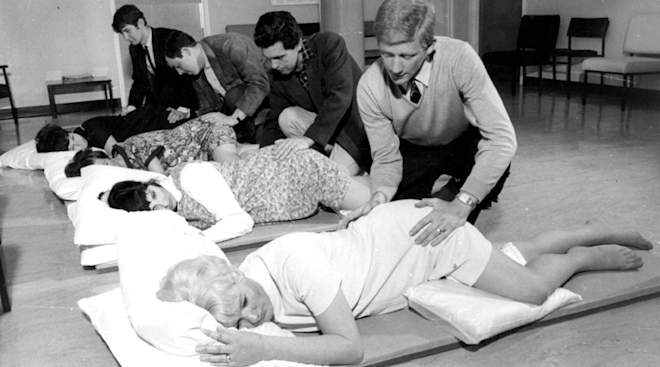Your Comprehensive Guide to Childbirth Classes
It’s the moment you spend your entire pregnancy gearing up for—but childbirth comes with pain and plenty of unknowns, so it’s no wonder moms-to-be feel some anxiety surrounding labor and delivery. But as they say, knowledge is power, and childbirth classes can be a great way to understand the birth process, ask questions and clear up any confusion and trepidation. These prenatal classes may also touch on newborn and infant care and could lead you to other resources that prove useful during the end of your pregnancy. You might even make friends with other parents due around the same time as you! But with so many different courses out there, how do you figure out which one to sign up for? Here’s what to know about the types of birthing classes, when and why you should take one and how to find one that’s right for you.
Do you need to go to a childbirth class? Not necessarily—but especially if you’re a first-time parent, the instruction they provide could be extremely helpful for you and your partner or whoever will be attending the birth with you. “I think everyone can benefit from a prenatal class,” says Megan Davies, a certified childbirth educator and owner of YEG Prenatal in Alberta, California. “Birth is one of the most intense, life-changing experiences a person can have. Birth is unpredictable, but knowing what options are available, understanding how the body works during labor and having an idea of what to expect from the whole process can make the experience much less scary.” Birthing classes are also beneficial for whoever will be supporting you during birth, since they’ll learn about what happens during labor and delivery, how to physically and emotionally comfort you and how they can advocate for you throughout the experience.
Most prenatal classes charge per couple, and they can get expensive and are likely not covered by insurance. The good news is that some childbirth classes are offered by local hospitals or community centers at a low or no cost.
Many childbirth education classes are general overviews of labor and delivery and may walk you through the following aspects of birth:
- the biology behind labor
- comfort and pain-alleviating techniques
- what the labor process looks like and what to expect from your medical team
- the role of your birth partner in the labor process
- what to know about epidurals
- what to know about c-sections
- information about breastfeeding and newborn care
Other birthing classes may have specific perspectives on how to manage labor. Here, a few popular techniques to consider.
Lamaze class
A lamaze class—or series of classes, since the curriculum spans 12 hours—is a popular option for moms-to-be. The practice was established in the 1950s by a French doctor and focuses on breathing and pain management techniques, how to labor (with or without drugs) and ways a birth partner can assist. While Lamaze classes are often perceived as being anti-epidural, they do go into pain medication options and describe what to expect if you decide to use pain interventions.
Is Lamaze for you? If you’re hoping for a drug-free birth (and can commit to a 12-hour course), Lamaze might be a great option, especially if you’re in your second trimester. Given its focus on the birth partner as well as the person giving birth, Lamaze is a good way to make sure you and your partner are on the same page when it comes to delivery.
The Alexander Technique
Unlike other childbirth class methods, the Alexander Technique is a movement technique used not just by moms-to-be but also by actors, dancers, people with back pain or posture issues, or people who simply wish to feel more relaxed in their body. The technique can help women with labor breathing and ways to focus on opening the body for birth, and can also assist in making pregnancy more comfortable. Classes may be traditional Alexander Technique classes adapted for pregnancy, or classes designed exclusively for pregnant people and their partners. The number of classes you wind up completing depends on your schedule and wishes, but proponents of the Alexander Technique suggest taking classes at least once a week.
Is the Alexander Technique for you? This method can provide relief for physical ailments during pregnancy as well as prep you for delivery, so it may be a good one to consider if you’re bothered by pregnancy aches and pains (after you get the all-clear from your doc). The gentle stretching and movement may also be good for parents who want to stay active during pregnancy.
Bradley Method
A 12-week course, the Bradley Method focuses on all aspects of childbirth, including how to stay healthy for the duration of your pregnancy. This birthing class focuses on techniques to help you through all stages of labor, what to expect if things don’t go according to plan and what the role of your birth partner can be. Some of the course content touches on infant care as well. An unmedicated, intervention-free birth is the goal of the class: According to a study, 86 percent of participants in the Bradley Method had a drug-free delivery.
Is the Bradley Method for you? Are you the type who feels there’s no such thing as too much preparation? The course-like nature of this approach can be a good option for parents who really want to immerse themselves in all aspects of the birth experience, as well as parents who are planning for a drug-free delivery. Since the course takes place over 12 weeks, it’s best to take this childbirth class when you’re in your second trimester. The fact that it’s an extended course also means it can be a great place to meet other parents with similar mindsets.
Birthing From Within
Birthing From Within, a concept developed by midwife Pam England, focuses on birth as being a transformative psychological and physical experience for parents-to-be. In addition to touching on pain management techniques and birth preparation, Birthing From Within focuses on the fears, goals and expectations you have surrounding labor and delivery and your feelings about impending parenthood. These birthing classes may involve drawing, journaling and other rituals, and may be conducted privately with you, your partner and a birth coach or in a small group class.
Is Birthing From Within for you? Parents curious about the emotional aspect of labor may be drawn to Birthing From Within. The fact that the course can be done privately can also be a big plus for parents worried that birth may bring up latent emotional trauma, or who may wish to have their questions and concerns explored in a private setting. If you have a planned c-section or have mixed feelings about a previous c-section, this class might be a good fit, since it can be tailored to vaginal or c-section delivery.
HypnoBirthing
Contrary to what you might imagine, hypnoBirthing has nothing to do with putting you in a trance. The philosophy behind this type of childbirth class points to fear and anxiety as contributing to pain, so you and your birth partner will learn deep relaxation techniques that can help reduce your fear and keep you present during labor. Hypnobirthing anticipates its students are hoping for a drug-free delivery: In one study, 80 percent of mothers who had taken a hypnoBirthing course elected not to have an epidural.
Is HypnoBirthing for you? Parents who believe in the power of mind over body or those with a lot of anxiety surrounding birth might find real value in HypnoBirthing. This type of childbirth class can also be great for a nervous birth partner, since it offers concrete ways they assist you in labor.
When to take a birthing class depends on your schedule and the type of course you’re signing up for, but most parents prefer to take childbirth classes in their second or early third trimester. “I generally recommend taking a prenatal class in the second trimester,” Davies says. “It’s far enough into the pregnancy that things are feeling real, but early enough that it’s not rushed. That means people can find a class that’s the right fit for their schedule, lifestyle and the kind of birth they’re hoping for. A second trimester class also allows time to practice techniques afterwards, and perhaps make changes to the care provider or birth plan if necessary, based on what has been learned in the class.”
There’s no “right” childbirth class method. “There are so many different philosophies and styles of childbirth education, just about everyone can find one that really works for them,” Davies says. “For some, this is the hospital class. For many others, they might find they connect more and feel more confident with an out-of-hospital class. Especially as a first-time parent, it’s definitely worth it to talk to some like-minded friends and do some research about what’s available. Don’t be afraid to call or email the class instructor and ask questions.”
When it comes to selecting a birthing class, it’s a good idea to keep a few factors in mind, including cost and convenience. Talking with other moms, asking for advice on a local parent’s message board or asking your OB for recommendations can be a great first step. What about online childbirth classes? These may also be an option, but you may miss out on the socialization and potential new parent friends you would get with an in-person class. It’s also important to suss out whether the online childbirth class is interactive or pre-recorded video sessions, which may prep you in the same way a book might, says Koyuki Smith, a Birthing From Within doula, childbirth educator and facilitator. “It’s not impossible for a live online class to replicate an in-person class in many ways,” she says. “Just go about the decision thoughtfully: Ask the instructor why they think the online format works, how they adjust their work for that format and how they deal with the inevitable challenges of distance learning.”
Like with any type of class, the more you put into it, the more you’ll likely get out of it—so it may be helpful to read any books recommended on the syllabus, come with questions and spend any breaks connecting with other parents rather than scrolling through your social media.
Childbirth classes for second-time parents
If you’re a second-time parent, you may wonder if you really need a childbirth class again. It’s of course up to you, but even for veteran parents, birthing classes can be helpful to brush up on basics, boost your confidence and give you some new strategies and tips for this birth experience. It can also be nice to connect with parents-to-be who are having their baby around the same time as you. “Because no two births are the same, every pregnant person faces the unknown no matter how many times they have given birth before,” Smith says. “Additionally, second- (or third- or fourth-) time parents are sometimes ‘stuck’ reliving the details of a previous birth (sometimes without even knowing it!) and need help gaining the perspective necessary to move ahead into the future.”
Childbirth classes and c-sections
If you’re having a scheduled c-section, should you take a childbirth class? It may be worth it—some birth coaches even offer c-section specific courses or coaching sessions. “Giving birth is a transformative rite of passage no matter how the baby emerges from the body,” Smith says. “Cesarean birth is just as psychologically and physically demanding as vaginal birth, though sometimes in different ways.” Many birthing classes focus on resilience, coping skills and how to handle the unexpected, which can be important for those undergoing c-sections.
Unlike college, you won’t flunk out if you don’t attend a birthing class, and there’s plenty of information to be found online and in books. But if you do have the time, it may be worth your while to attend a class to understand what the birth process may be like, ask any questions and—like college—meet the people who may just become your future BFFs.
Please note: The Bump and the materials and information it contains are not intended to, and do not constitute, medical or other health advice or diagnosis and should not be used as such. You should always consult with a qualified physician or health professional about your specific circumstances.
Plus, more from The Bump:
Navigate forward to interact with the calendar and select a date. Press the question mark key to get the keyboard shortcuts for changing dates.




















































